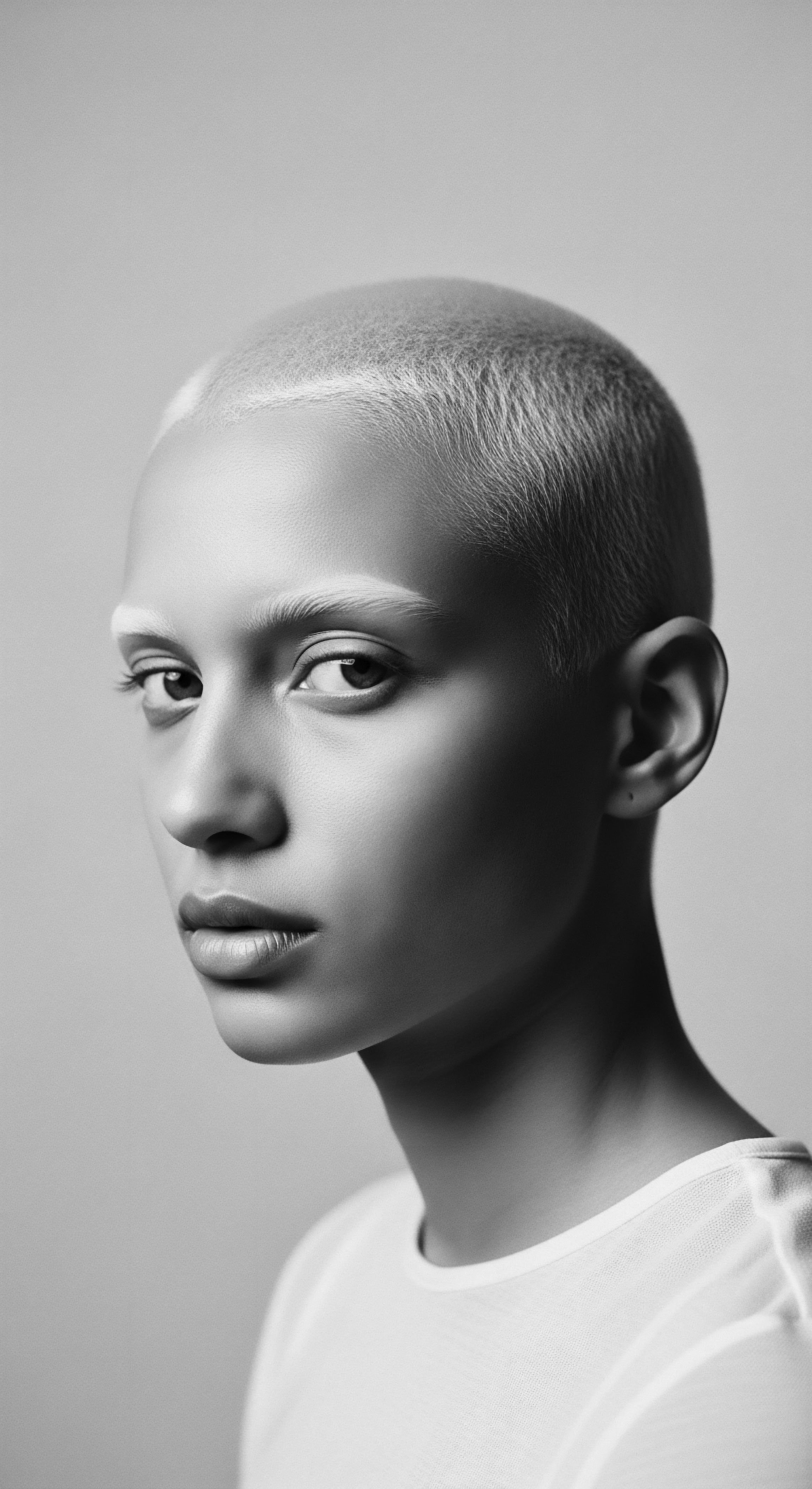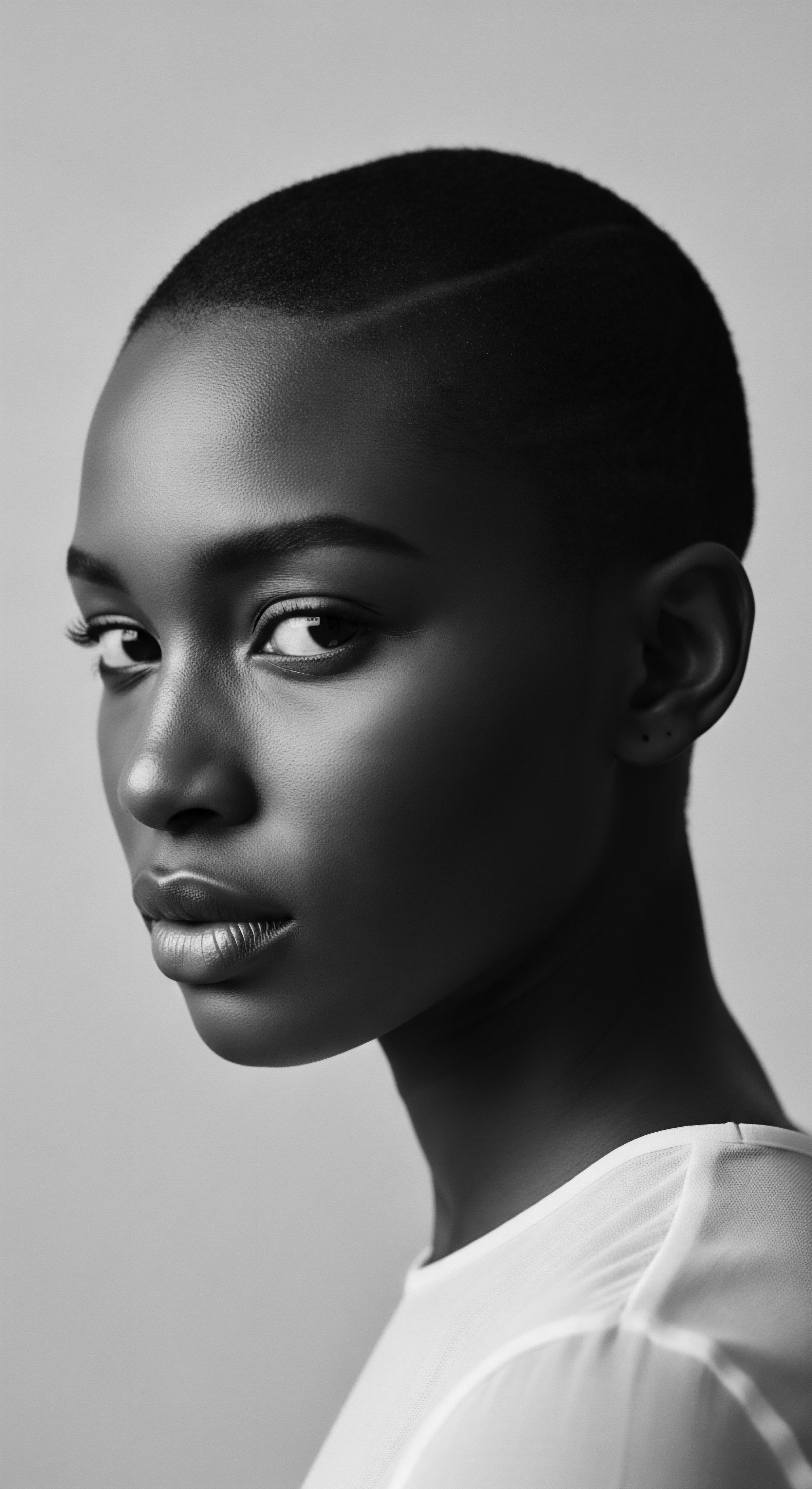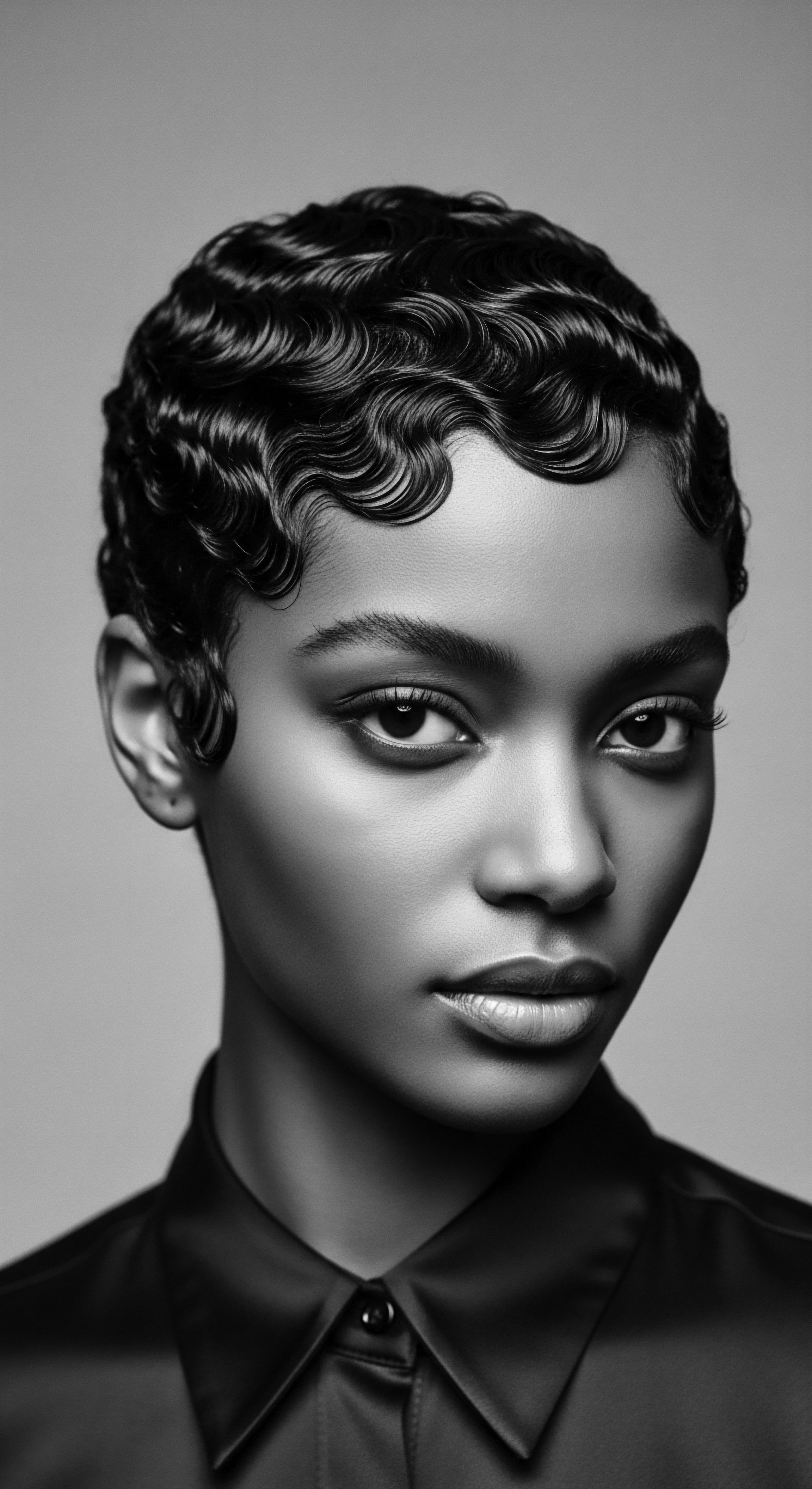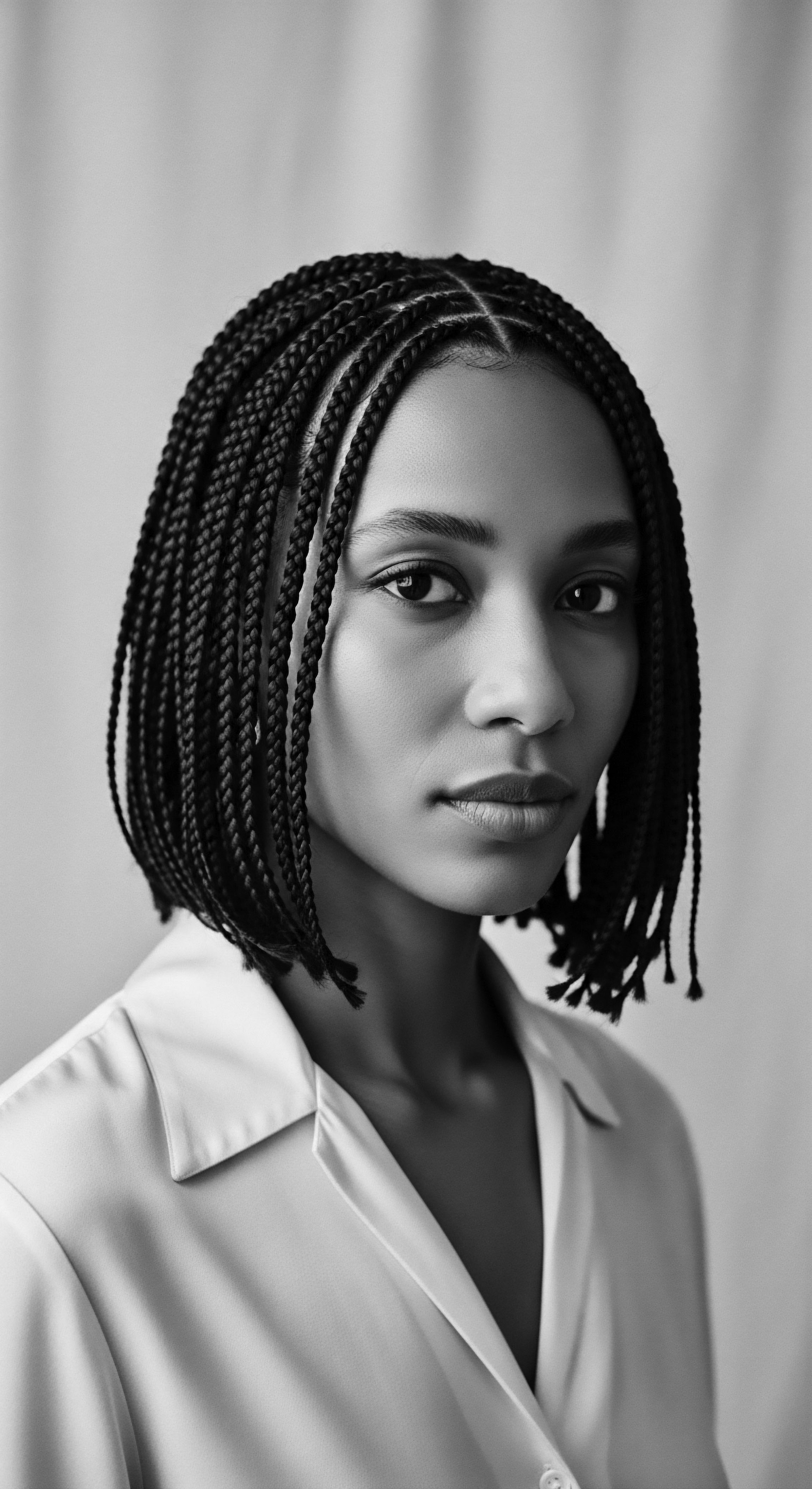
Roots
Consider for a moment the very helix of being, the coiled strands that have always adorned the heads of Black and mixed-race peoples. These natural adornments are more than simple biological structures; they are living archives, resonant with stories of resilience, cultural adherence, and profound generational wisdom. To truly comprehend ancestral hair oiling practices is to journey into the heart of this identity, where each application of a nourishing balm or liquid plant extract serves as a profound connection to the earth, to community, and to a lineage stretching back through time. It is a dialogue between the elemental makeup of our hair and the elemental gifts of our ancestors, a sacred exchange that speaks volumes without a single uttered phrase.
The unique composition of textured hair, with its characteristic curl patterns ranging from loose waves to tightly coiled structures, presents distinct requirements for hydration and care. Unlike straighter forms of hair, the natural oils produced by the scalp, known as sebum, encounter a longer, more circuitous path along a curled strand. This journey makes it more challenging for these vital lubricants to reach the ends of the hair shaft, often resulting in increased susceptibility to dryness and, subsequently, breakage.
Ancestral communities, long before the advent of contemporary scientific classification, intuitively understood these inherent qualities. Their practices were not born of casual observation; they were forged through generations of intimate engagement with their own hair, an understanding passed down with reverence.
The morphology of each strand, with its particular elliptical shape and varying cuticle layer, impacts how moisture is retained or released. The outer layer of the hair, the cuticle, composed of overlapping scales, offers protection. For textured hair, these scales may be more lifted at the curves of the strand, creating opportunities for moisture to escape. It is precisely this innate characteristic that ancestral oiling practices sought to address, providing an external barrier and replenishing vital lipids.

What Did Ancestral Wisdom Teach About Hair Structure?
Long before modern microscopes unveiled the intricate architecture of a hair shaft, ancient communities held an intrinsic awareness of their hair’s distinct attributes. Their knowledge, transmitted through observation and communal wisdom, informed every aspect of their hair care. They understood that certain hair types craved deep conditioning and gentle handling, a sensibility that guided their selection of natural substances.
The term “natural butters” frequently appears in accounts of traditional hair care, referring to plant-based fats that provided essential moisture and protection. These substances, extracted from local flora, formed the cornerstone of routines aimed at preserving the strength and vitality of textured hair.
The use of specific plant oils and butters was a response to environmental conditions and the intrinsic nature of the hair itself. In West African traditions, for instance, a profound understanding of botanical properties led to the widespread use of shea butter, often paired with protective styles to maintain both length and general well-being in hot, arid climates. This historical application was not arbitrary; it directly countered the propensity for moisture loss in highly textured hair, acting as a sealing agent against environmental elements.
Ancestral hair oiling practices emerge from a deep, intuitive understanding of textured hair’s fundamental needs for hydration and protection.
The terminology employed by different groups often reflected this intimate knowledge. While modern systems categorize hair based on curl patterns, ancestral vocabularies likely described hair by its visual characteristics, its feel, and its response to care. These descriptions were not merely aesthetic; they were practical, informing the choice of specific plants and the methods of their application.

How Were Hair Cycles Managed Historically?
The rhythms of hair growth, shedding, and rest, universal across human populations, were acknowledged and accounted for in ancestral hair care. While scientific terminology such as anagen, catagen, and telogen phases may not have been part of their lexicon, the observable cycle of hair growth, its periods of vibrancy, and its eventual release, certainly were. Practices like gentle detangling, regular cleansing with natural substances, and the application of oils supported the hair’s natural progression. Such routines aimed at maintaining a healthy scalp environment, understood as the foundation for vibrant hair.
Consider the daily realities of ancient African life. Exposure to sun, dust, and laborious activities would have necessitated robust hair care. Oiling offered a shield against environmental stressors. It aided in detangling, minimizing the mechanical stress that could lead to breakage, particularly during the telogen (resting) phase when hair is more vulnerable.
The very act of applying oils often involved scalp massage, which, through gentle manipulation, could stimulate circulation and support the health of the follicular units. This systemic approach to care, spanning from ingredient selection to application method, underscores a sophisticated, albeit unwritten, science of hair vitality rooted in generations of practical wisdom.
| Ancestral Wisdom Emphasis on moisturizing dry strands with rich butters. |
| Contemporary Perspective on Textured Hair Acknowledges lower sebum travel along coils necessitates external hydration. |
| Ancestral Wisdom Protective styling to shield hair from external elements. |
| Contemporary Perspective on Textured Hair Recognizes reduction of mechanical stress and environmental exposure. |
| Ancestral Wisdom Scalp preparations for health and comfort. |
| Contemporary Perspective on Textured Hair Supports the importance of a healthy scalp microbiome for optimal growth. |
| Ancestral Wisdom Natural ingredients selected for their beneficial properties. |
| Contemporary Perspective on Textured Hair Validates botanical compounds for their nourishing and protective qualities. |
| Ancestral Wisdom The enduring wisdom of ancestral practices continues to guide effective care for textured hair in the present day. |

Ritual
The hands that moved through hair in ancestral times did not merely perform a task; they orchestrated a ritual. These were moments of communion, of teaching, of connection, woven into the fabric of daily existence. Hair oiling, as an integral part of these grooming ceremonies, transcends the mere application of a product.
It speaks to a profound cultural significance, a communal act that fortified bonds and transferred invaluable knowledge from one generation to the next. The heritage of these practices resides not solely in the ingredients used, but in the tender hands that administered care, the stories shared, and the collective identity affirmed through each braided strand or massaged scalp.
For Black and mixed-race communities, hair has long served as a profound marker of identity, status, and spirituality. The detailed styling practices, often requiring hours of meticulous work, were social occasions. Mothers, daughters, aunts, and friends would gather, engaging in a communal activity that cemented relationships while passing on intricate techniques and the knowledge of specific botanical applications. This collective approach to hair care meant that ancestral oiling practices were not solitary acts, but rather shared experiences, reinforcing community ties.

How Did Oiling Aid Ancestral Styling?
Ancestral hair oiling was a preparatory step, a foundational element before shaping strands into intricate styles. These emollients provided pliability, making tightly coiled or dense hair more manageable for manipulation into braids, twists, and knots. Beyond lubrication, the oils also added a sheen, reflecting health and vibrancy.
They served to seal the cuticle, minimizing the risk of breakage during the styling process itself and providing a protective barrier against environmental dust and dryness. The oils were not merely an addition; they were an essential component of the physical transformation of hair, allowing for the creation of styles that sometimes took days to complete and were meant to last for extended periods.
Consider the Himba people of Namibia, renowned for their distinctive use of Otjize, a paste of butterfat and red ochre. This concoction is not only a cosmetic marvel, signifying stages of life and beauty, but also a protective agent. It shields hair and skin from the harsh sun and insects, while simultaneously cleansing and conditioning. The application of otjize is a daily ritual, performed by women and passed down through the generations, underscoring the functional and symbolic depth of such practices.
Ancestral hair oiling transformed hair into a pliable medium, ready for the intricate artistry of traditional styling.
The tools employed during these rituals were often simple, yet deeply effective. Combs, crafted from wood or bone, were designed to navigate coiled textures without causing undue damage. Natural fiber brushes and even hands, often coated with oil, gently smoothed and distributed products. The choice of specific oils might depend on regional availability and desired effects ❉
- Shea Butter (from the karite tree) ❉ Widely used across West Africa, known for its moisturizing and softening properties.
- Castor Oil ❉ A staple in many African and diasporic communities, valued for its purported ability to strengthen strands.
- Coconut Oil ❉ Common in coastal regions and certain parts of Africa, a lighter oil that provided sheen and mild conditioning.
- Karkar Oil (a blend) ❉ Used in Sudan and Chad, often infused with specific herbs to aid in growth and conditioning.
These ingredients were not just applied; they were massaged in, warmed by the hands, and worked into the strands, creating a sensory experience that reinforced the care being provided.

What Transformations Did Oiling Support?
The transformation of hair through ancestral oiling and styling went beyond the physical. It was a metamorphosis of self, a declaration of belonging, and a visual representation of personal and communal narratives. Styles could communicate marital status, age, social rank, or even religious affiliations. The very act of preparing the hair with oils before styling contributed to its capacity to hold these elaborate forms, allowing individuals to carry their identity and heritage visibly.
The ingenuity displayed in creating these styles speaks to a profound artistic sensibility, where hair became a canvas for expression. From the elaborate cornrows found across the continent to the distinctive locs, each style carried a story, often maintained and refreshed with the help of oils to preserve their integrity and longevity. This continuum of care, from the preparation of the oils to the intricate styling, highlights a holistic approach to hair that recognized its interconnectedness with identity, community, and the spiritual world. The resilience of these traditions, even through periods of forced cultural suppression, stands as a testament to their deep-seated importance.

Relay
The transfer of ancestral wisdom is not a static lesson; it is a living, breathing relay. This generational passing of knowledge ensures that the practices of yesteryear, particularly those surrounding hair oiling, continue to inform and enrich care routines today. For Black and mixed-race communities, daily hair care is a direct link to this continuity, a conscious decision to uphold traditions that have long sustained the vitality of textured hair. This section delves into the daily regimen, the sanctity of nighttime rituals, and the solutions derived from time-honored practices, all filtered through the lens of accumulated wisdom.
Ancestral wellness philosophies often viewed the body, including the hair, as an interconnected system. Health of the hair was not separate from overall bodily health, diet, and spiritual well-being. This holistic understanding guided the creation of hair care regimens, which included not only external applications but also considerations of nutrition and communal support. The ritual of hair oiling was a central pillar in this comprehensive approach, designed to maintain the integrity of strands and the health of the scalp against daily life’s challenges.

How Does Ancestral Wisdom Inform Modern Hair Routines?
The rhythms of care in ancestral communities were often dictated by the natural world and the demands of daily life. For textured hair, which tends to be prone to dryness due to its coiled structure, consistent moisture was, and remains, paramount. Ancestral oiling practices provided this vital hydration and protective seal.
Today, this understanding translates into modern routines that prioritize moisture retention through regular application of leave-in conditioners and sealing oils. The wisdom of layering products, though perhaps not formally articulated, existed in the practice of applying butters after water-based treatments to lock in hydration.
An enduring example of this integrated approach lies in the use of traditional ingredients. A comprehensive review of African medicinal plants identified 68 species used for hair care, targeting issues such as dryness and various scalp conditions. Many of these plants yield oils or butters with documented benefits for hair vitality and health. The consistent use of such ingredients speaks to a deep, empirical knowledge of their properties, passed down and refined over centuries.
Nighttime care, a seemingly contemporary concern, holds ancestral echoes. While modern society relies on silk bonnets or pillowcases, historical records suggest similar efforts to protect hair during sleep. Head wraps and coverings, often made from natural fibers, served to shield elaborate styles from disarray and maintain moisture, particularly in environments with dry air. This foresight prevented tangles and breakage, preserving the integrity of labor-intensive styles and maintaining scalp comfort.
The legacy of ancestral hair oiling continues to guide modern hair care, emphasizing consistent moisture and protection for textured strands.

What Traditional Remedies Address Common Hair Issues?
Problems like dryness, breakage, and scalp irritation are not new. Ancestral communities, through their intimate connection with nature, developed an array of remedies. Hair oiling was central to this problem-solving compendium.
- Dryness ❉ Rich butters like shea butter and cocoa butter were massaged into hair and scalp, providing deep conditioning and a protective layer.
- Breakage ❉ Oils believed to strengthen hair, such as castor oil or specific plant extracts, were applied with gentle motions, sometimes as a preventative measure.
- Scalp Conditions ❉ Certain infused oils or herbal concoctions were used to soothe irritation, address flaking, or cleanse the scalp, recognizing its role as the foundation for healthy hair.
- Tangles ❉ The slipperiness of oils aided in gentle detangling, preventing further damage during grooming.
The connection between hair health and overall well-being was always present. Ancestral practices often intertwined hair care with broader wellness rituals, recognizing the impact of diet, stress, and spiritual harmony on physical appearance. The ingredients themselves were often dual-purpose, used not only for hair but also for skin, or even consumed for internal benefits.
This approach reflects a profound understanding of systemic health, where external applications mirrored internal care. The emphasis on natural, locally sourced ingredients also aligned with a sustainable way of life, minimizing waste and maximizing efficacy through direct access to botanical gifts.
| Traditional Oil/Butter Shea Butter |
| Ancestral Benefit and Use Moisturizing, protecting from sun and elements, soothing scalp. |
| Modern Scientific Corroboration Rich in fatty acids (oleic, stearic, linoleic), vitamins A, E, F. Known for emollient and anti-inflammatory properties. |
| Traditional Oil/Butter Castor Oil |
| Ancestral Benefit and Use Strengthening, promoting growth, adding shine to strands. |
| Modern Scientific Corroboration High in ricinoleic acid, which possesses anti-inflammatory qualities and may stimulate hair growth via prostaglandin E2 receptors. |
| Traditional Oil/Butter Coconut Oil |
| Ancestral Benefit and Use Conditioning, adding luster, reducing protein loss. |
| Modern Scientific Corroboration Contains lauric acid, which has a high affinity for hair proteins and can penetrate the hair shaft, reducing protein loss before and after washing. |
| Traditional Oil/Butter Argan Oil |
| Ancestral Benefit and Use Deep conditioning, frizz reduction, environmental protection. |
| Modern Scientific Corroboration Composed of fatty acids, vitamin E, and antioxidants; helps improve hair elasticity and overall health. |
| Traditional Oil/Butter The enduring utility of these ancestral oils is affirmed by both long-standing practice and contemporary scientific insight. |
The evolution of these practices, even through the harrowing eras of forced migration and cultural suppression, speaks to the incredible adaptive capacity of Black communities. Deprived of traditional ingredients and tools during slavery, individuals creatively repurposed what was available, often using rudimentary substances. Yet, the intent of care, the underlying philosophy of nourishment and protection, persisted. This persistent thread, linking past ingenuity with present-day routines, underscores the profound staying power of ancestral wisdom in hair care.

Relay
The relay of knowledge, from elder to youth, from tradition to daily practice, is a vibrant current within the ongoing story of textured hair. It is here, within the sophisticated layers of ancestral hair oiling, that we encounter not just historical anecdotes, but a living science, refined through generations of meticulous observation and intuitive understanding. Our examination extends beyond surface-level descriptions to explore how these practices, rooted in the deepest sense of heritage, offer profound solutions and shape identity.
The deliberate selection and preparation of plant-based oils and butters were underpinned by a detailed understanding of their properties and effects on hair. This knowledge was empirical, tested over centuries. For instance, the use of various plant species for their effects on hair growth, anti-dandruff qualities, or ability to manage hair loss is well-documented in ethnobotanical studies across Africa.
The family Lamiaceae, for example, is highly represented in such traditional remedies, often yielding essential oils with cosmetic value. This highlights a sophisticated botanical literacy, where specific plants were chosen for specific hair conditions, suggesting an ancient form of targeted care.

How Do Environmental Demands Shape Ancestral Hair Care?
The environments in which many ancestral Black communities lived presented unique challenges for hair health. Arid climates, intense sun exposure, and the demands of agricultural or nomadic life necessitated protective hair care. Hair oiling served as a crucial defense mechanism.
It provided a barrier against moisture evaporation, shielded strands from damaging UV radiation, and helped to keep dust and debris from adhering to hair, which could lead to tangles and breakage. This adaptability to environmental pressures speaks to the practical ingenuity of these practices, ensuring hair could withstand daily rigors while maintaining health.
The historical accounts often describe hair care not as a quick application but as an elaborate process, sometimes taking hours or even days. This extended period allowed for deep penetration of the oils, thorough detangling, and the careful formation of protective styles. Such dedication to the process underscores the deep respect for hair as a vital component of identity and well-being.
One significant example lies in the Yoruba culture of Nigeria, where hair holds immense spiritual power. Hair is considered the most elevated part of the body, a conduit for spiritual energy, and braided hair can convey messages to deities. The intricate process of styling includes washing, combing, oiling, braiding, and decorating, an elaborate ritual that also served as a social bonding opportunity. The consistent oiling in such rituals would have ensured the hair remained supple and strong enough to endure the complex manipulations and adornments, maintaining its symbolic integrity.
Ancestral hair oiling practices were finely tuned responses to environmental demands, offering robust protection and maintenance for textured hair.
The impact of the transatlantic slave trade profoundly disrupted these established practices. Enslaved Africans were often stripped of their traditional tools, their natural hair care ingredients, and the time necessary for elaborate rituals. Their hair was frequently shaved, a deliberate act of dehumanization and cultural erasure. Yet, despite these brutal disruptions, the knowledge and inclination towards hair care persisted.
Enslaved people resourcefuly adapted, using available substances like kerosene, bacon grease, or butter, not for optimal care, but as a desperate measure to manage matted and tangled hair. This forced adaptation, though traumatic, speaks to the enduring human drive to preserve identity, even in the face of profound oppression. The very act of attempting to care for one’s hair became a quiet, powerful act of resistance, a hidden affirmation of a stolen heritage.

What Are the Lasting Implications of Ancestral Hair Oiling?
The historical journey of Black hair care, including ancestral oiling, has deep implications for contemporary understanding and practice. The resilience shown in maintaining these traditions, even when faced with adversity, speaks to their profound cultural weight. Today, the resurgence of interest in “natural hair” movements is, in many ways, a direct continuation of this ancestral legacy. It represents a conscious return to practices that honor the unique characteristics of textured hair and reject Eurocentric beauty standards.
Modern science often validates the efficacy of these time-honored methods. The molecular structures of many traditional oils, rich in fatty acids, antioxidants, and vitamins, are now understood to provide deep conditioning, seal in moisture, and protect the hair shaft. This confluence of ancient wisdom and modern inquiry creates a fuller appreciation for the depth of ancestral knowledge.
The continued use of oils like shea butter, coconut oil, and castor oil, not just in their raw forms but also incorporated into contemporary formulations, is a testament to their enduring value. This practice is not merely about physical appearance; it is about reclaiming narratives, asserting identity, and nurturing a connection to a powerful lineage.
The ongoing commitment to ancestral hair oiling, often passed down within families, solidifies community bonds and reinforces cultural identity. It reminds us that hair care is not a solitary endeavor, but a shared experience, rich with historical echoes and collective meaning. It is a daily reaffirmation of strength and beauty, drawing from the deep well of inherited wisdom.

Reflection
The story of ancestral hair oiling, intertwined with the very fabric of Black identity and heritage, remains a living testament to a profound connection. It is a dialogue between human hands, natural elements, and the inherent vitality of textured strands. This exploration into the rituals of care, the discerning selection of ingredients, and the deep cultural resonance of these practices, reveals a lineage of wisdom that extends far beyond superficial grooming.
Each droplet of oil, each gentle stroke, carries the echoes of countless generations, of hands that learned to nourish and protect, to communicate and celebrate through the language of hair. The insights gleaned from a cultural historian’s perspective, the tender guidance of a wellness advocate, and the clarifying lens of a scientist converge to affirm one undeniable truth ❉ hair oiling practices are not relics of the past. They are vibrant expressions of identity, enduring symbols of resilience, and powerful conduits to a heritage that continues to shape and inform the present. They are, indeed, the very soul of a strand, continuing their quiet, vital relay into the future.
References
- Bebrų Kosmetika. (2024). The Power of Hair in African Folklore ❉ Rituals and Traditions.
- Walker, M. C. J. (1906). A’Lelia Walker’s Hair Care Manual.
- Katz, R. (1993). The Straightening of America ❉ The War on Black Hair.
- Morgan, G. A. (1894). The George T. Morgan Hair Refiner Patent.
- Byrd, A. D. & Tharps, L. L. (2014). Hair Story ❉ Untangling the Roots of Black Hair in America.
- Hooks, B. (1992). Black Looks ❉ Race and Representation.
- MDPI. (2022). Afro-Ethnic Hairstyling Trends, Risks, and Recommendations.
- Tharps, L. L. & Byrd, A. D. (2002). Hair Story ❉ Untangling the Roots of Black Hair in America.
- MDPI. (2024). Cosmetopoeia of African Plants in Hair Treatment and Care ❉ Topical Nutrition and the Antidiabetic Connection?
- Ethnobotany Research and Applications. (2025). Plants Used for Hair and Skin Health Care by Local Communities of Afar, Northeastern Ethiopia.
